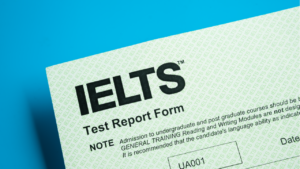The International English Language Testing System (IELTS) is widely recognised as one of the most popular and respected English language proficiency tests worldwide. Over 11,000 organisations accept it in more than 140 countries like the USA, UK, Canada, Australia and many more.
Every year, over three million people take the IELTS exam, which is growing steadily. It comprises 4 sections-
The IELTS Speaking Test is particularly significant and challenging for a few candidates. It consists of 3 Parts: Introduction and Interview, Cue Card Round, and Long Discussion.
As an IELTS aspirant, one of the tasks you will encounter during your IELTS Speaking Test is the cue card section. These topics test your ability to describe things and your communication skills. The key is providing a clear, detailed answer while engaging your audience.
To better understand the IELTS Speaking test, look at “Describe a Person Who Wears Unusual Clothes” and learn ways to present this section in the best way possible.
Leap Advantage Virtual Spot Offer Event on May 10th 2024

Last call to secure your spot for Masters in STEM Program in the US for Fall ’24 exclusively for graduates and above.
Leap Advantage Virtual Spot Offer Event on May 10th 2024
Last call to secure your spot for Masters in STEM Program in the US for Fall ’24 exclusively for graduates and above.

IELTS Speaking Section
The IELTS is a standardised test that measures your English proficiency. Among the 4 modules, the Speaking section is the most interactive and personal.
The Speaking Test is 11 to 14 minutes long. It consists of three parts, each designed to evaluate different aspects of your speaking skills.
The Three speaking sections are:
| Part 1– Introduction and Interview: The examiner will ask general questions about yourself, your family, work, likes, dislikes and more. Part 2– Cue Card Segment: In this part, you must speak on a given topic for two minutes. You will have one minute to prepare your response. Part 3– Long Discussion: The examiner will ask you follow-up questions related to the topic discussed in Part 2. |
Let us understand the IELTS Speaking Part 2: Cue Card Section.
IELTS Speaking Part 2: Cue Card
Part 2 of the IELTS Speaking test is the Cue Card or the Talk section. The Cue Card is a crucial part of the IELTS Speaking Test, usually in the middle of the exam.
It tests your ability to speak fluently on a topic and organise your thoughts effectively. The Cue Card round is allotted 3-4 minutes of speaking time, and the examiner will give you a cue card with a topic.
Total Duration of IELTS Speaking Part 2
| Duration of IELTS Speaking Part 2 | 3-4 minutes |
| Preparation Time | 1 minute |
| Speaking Time | 2-3 minutes |
You will have one minute to prepare your notes and two minutes to speak on the topic. Use your preparation time wisely and jot down key points you want to cover in your speech. You can use abbreviations or short forms to save time, but ensure you can understand them later.
When you are done speaking for the two minutes are up, the examiner will ask you one or two follow-up questions about the topic. This is your chance to showcase your ability to express your perspectives and ideas in more detail and to provide examples and details to support them.
Let’s explore sample answers for the IELTS Cue Card given below.
| Describe A Person Who Wears Unusual Clothes. Talk about these topics: Who is he/she? How do you know him/her? What kind of clothes does he/she wear? Why do you consider that his/her clothing choices are weird? |
It’s essential to have a clear structure in your speech and cover everything the prompt asks. Follow the step-by-step instructions to answer the questions effectively.
Crack IELTS Exam in first attempt

Attend Leap’s free masterclass to get tips, tricks and advance strategies to crack IELTS exam in first attempt
Crack IELTS Exam in first attempt
Attend Leap’s free masterclass to get tips, tricks and advance strategies to crack IELTS exam in first attempt

Sample Answer 1
Question:
- Who is he/she?
Answer:
Provide a brief overview of the person in question. It can include their name, relationship to you, and critical characteristics or roles they hold in your life.
- “The person in question is my childhood friend, Ankita. We’ve been friends for as long as I can remember, sharing countless adventures and experiences. She is a free-spirited and creative girl.”
Question:
- How do you know him/her?
Answer:
Elaborate on your relationship with the person. Explain where and when you met her. Keep it concise and focused.
- “I know Ankita from our early school days, and we’ve shared many memories growing up together. Our friendship goes way back, allowing me to witness Ankita’s evolving fashion choices.”
- “Her clothing choices are unusual because they don’t follow the typical fashion norms. Instead, Ankita prefers outfits that express her personality.”
Question:
- What kind of clothes does he/she wear?
Answer:
When describing the person’s clothing style, focus on general categories rather than specific brands or fashion trends. Mention the person’s preferences and provide a few examples of outfits they commonly wear.
- “She wears various types of clothing, ranging from bold and vibrant colours to outfits with unique patterns. Her wardrobe includes bizarre combinations, mixing styles and colours, which differs greatly from society’s traditional fashion choices.”
Question:
- Why do you consider his/her clothing choices weird?
Answer:
If you believe the person’s clothing choices are weird or unique, explain your perspective without being judgmental. Highlight specific aspects of their style that stand out to you.
- “Ankita’s wardrobe is full of colours and patterns. Her clothes are far from ordinary, from digital prints to bold combinations. Whether mixing different styles or experimenting with accessories, her fashion sense includes creativity and self-expression.”
- “Her clothing choices are unusual because they differ from mainstream fashion norms. The uniqueness of her clothing choices stands out in a crowd. This differentiation from the norm is weird but also admirable, as it showcases a bold and confident approach to styling.”
Sample Answer 2
Question:
- Who is he/she?
Answer:
Start by introducing the person briefly. Mention their name and a brief description of their personality.
- “Ranveer Singh is a well-known Bollywood actor. He’s recognised for his distinct style, often wearing eye-catching outfits.
Question:
- How do you know him/her?
Answer:
Provide a simple explanation of how you know the person. Keep the answer short and straightforward.
- “I know Ranveer Singh from his movies and public appearances. He is a versatile actor. However, recently, he has been popular across all social media platforms. The reason is his unique clothing style and uncommon fashion sense, which has sparked several conversations.”
Question:
- What kind of clothes does he or she wear?
Answer:
Describe the person’s typical clothing style. Mention what makes their style of clothing different from the traditional norms.
- “Ranveer Singh is known for wearing various clothes, such as casual, formal, sporty and bold. But, his most talked about outfits consist of vibrant colours, different kinds of patterns and expensive pieces of jewellery. Due to his bold fashion choices, he has become the fashion icon of the country.”
Question:
- Why do you consider his/her clothing choices weird?
Answer:
Explain your perspective on their clothing choices in a non-judgmental way. Keep it subjective and avoid using strong opinions.
- “Some people might find Ranveer Singh’s clothing choices weird because they differ from the usual fashion styles. His bold and modern style challenges traditional expectations, opting for eye-catching designs and bright colours. While it may be considered weird by some, others appreciate it as a form of self-expression and a break from the norm in fashion.”
IELTS Speaking Part 3: Discussion
The IELTS Speaking Part 3 is a two-way discussion between you and the examiner. You must demonstrate your English language skills using various words and phrases. You should also share your opinions and examples from your own experiences. It helps in improving your overall IELTS band score.
Let’s talk about clothing styles in your country.
Question:
- Where do people from your country buy clothes?
Answer:
Begin by mentioning where people in your country buy clothes. You can briefly explain why individuals choose one place over another.
- “In my country, people typically buy clothes from various places such as department stores, clothing boutiques, and online shops. Many prefer shopping malls due to the wide variety of options available, while others opt for local markets for budget-friendly choices. Online shopping has also become famous for its convenience.”
Question:
- What’s the difference between men’s and women’s clothes choices?
Answer:
Explain the primary differences between men’s and women’s clothing choices, emphasising style, colour, and design.
- “Men and women often differ in their clothing choices based on societal norms and personal preferences. Generally, women may explore a broader range of styles and colours, while men prefer classic and formal options. Additionally, women’s fashion evolves rapidly with trends, whereas men’s fashion tends to be more timeless.”
Question:
- Do clothes affect people’s mood?
Answer:
Acknowledge that clothes can influence mood, providing examples of how wearing different types of clothing can affect how someone feels.
- “Indeed, clothes can influence a person’s mood. Wearing comfortable and favourite outfits may boost confidence and happiness. In contrast, ill-fitted clothes may lead to discomfort and negatively affect overall mood. The connection between clothing and mood is a psychological aspect that highlights the importance of personal style and comfort.”
Question:
- What do people consider when buying clothes?
Answer:
Mention the factors people typically consider when buying clothes, such as style, comfort, price, and occasion.
- “People typically consider comfort, style, price, and occasion when purchasing clothes. Comfortable fabrics and the right fit are essential for day-to-day wear, while the relevancy of the style often depends on the event or situation. Price also plays a significant role, with many individuals balancing quality and affordability when making clothing choices.”
Question:
- How often do people go to buy clothes?
Answer:
Explain that the frequency of buying clothes differs from person to person and is influenced by factors like fashion preferences and budget.
- “The frequency of buying clothes varies among individuals. Some people shop regularly, perhaps seasonally, to stay in tune with fashion trends. Others may prefer occasional shopping, replacing items as needed. The frequency also depends on personal preferences and lifestyle factors.”
Tips for IELTS Speaking
Here are ten tips for IELTS speaking tests to improve your overall band score and English language proficiency.
1. Speak Clearly when answering questions. Pronounce your words clearly and maintain a steady pace. Avoid speaking too fast, as it may affect your pronunciation.
2. Expand Your Answers by providing additional details. It showcases your ability to express ideas and can improve your overall performance.
3. Regular Practice is essential. Engage in conversations with friends or family to build confidence in expressing your thoughts in English.
4. Use a variety of vocabulary words to express yourself. Avoid repetition and showcase your ability to use diverse vocabulary. It will improve your overall band score.
5. Mind Your Pronunciation. Pay attention to word stress and intonation, which is crucial in the IELTS Speaking test.
6. Stay Calm and Collected. Take a deep breath if needed, and don’t let nervousness affect your communication ability.
7. Be Mindful of Time. Keep track of the time allotted for each IELTS speaking test part. Manage your time wisely to ensure you adequately address all questions.
8. Listen Actively to the examiner’s questions and instructions. It helps you provide relevant and appropriate responses.
9. Familiarise Yourself with Common Topics. This preparation ensures you are ready to discuss various subjects during the test.
10. Take Constructive Feedback. Request feedback from teachers, peers, or language exchange partners.
Summing Up
The IELTS Speaking test is integral to the IELTS exam. Its purpose is to evaluate how well you can talk in English.
You can better understand the IELTS speaking test by practising with sample test papers. Reading English books, watching English movies, and talking to people who speak English as their first language can all help you improve your English.
Remember, consistent effort and practice will significantly improve your success in the IELTS speaking test. Good luck!
Talking to an IELTS counsellor is also helpful if uncertainty improves in the IELTS speaking test. Counselling can help you determine what you need to work on, like grammar, words, and speaking skills.
To learn more about the IELTS Speaking Test, contact Leap Scholar Counsellors and start your IELTS preparation today.
Frequently Asked Questions
Q. How many parts are in the IELTS Speaking Test?
A. There are three parts to the IELTS Speaking Test.
The first part is the introduction and interview, which includes questions about your home, family, studies, work, and hobbies.
The second part is a cue card with questions and ideas. You have two minutes to answer the questions in the text.
Discussion is the last part. You and the examiner will have a two-way discussion about the complex problems raised in the previous part.
Q. Can I use humour in my IELTS Speaking response?
A. It’s okay to add humour, but do it carefully. Ensure the jokes fit the culture and are not likely to be misunderstood or offensive. Using humour can make your speech more interesting, but finding the right balance to sound professional is essential. Otherwise, it can affect your overall performance and IELTS band score.
Q. Is asking the examiner questions during the IELTS Speaking test appropriate?
A. Usually, you’re not supposed to ask the person testing you any questions while answering. The way the test is set up is meant for you to demonstrate your speaking skills on your own. But you can still involve them indirectly by giving detailed answers that make them want to ask you more questions.
Q. How important is the timing in the IELTS Speaking test?
A. Make sure you use your time wisely – take one minute to get ready and two minutes to talk. Use that first minute to plan what you’ll say. Try not to talk too long, though, or it might mess up the rest of the test. Do not use filler words. Use small phrases in the middle of your answers, such as, that’s a good question, let me see, etc. It will extend your speaking time.
Q. Can I use complex vocabulary even if I’m unsure of its pronunciation?
A. Even though using complex vocabulary is good, ensuring your message is clear is essential. If you’re unsure how to say a word, choose a simpler one to avoid confusion. Speaking is necessary; using words you know well will make you sound more polished. If you make a mistake in pronunciation of the complex words, it might affect your score.
Q. What questions are asked on the IELTS cue card for something?
A. The IELTS test is designed to assess proficiency in individuals who wish to study or work in English-speaking countries.
The types of questions one can get in the speaking section are:
“Describe a place you would like to visit.”
“Talk about a hobby or activity you enjoy.”
“Describe an achievement you are proud of.”
Q. Can I give personal examples in the IELTS Speaking Test?
A. Yes! It’s good to talk about things that happened to you. It makes your point more straightforward and shows you know what you’re discussing. Make sure your stories relate to the topic and add to the conversation. Keep your answers short and concise to avoid any kind of mistakes.
Q. How long should my responses be in the IELTS Speaking Test?
A. Try to keep your answers short, around 1-2 minutes. Make sure you give a complete answer without getting off track. Practice speaking steadily and finding the right balance between being brief and covering all the crucial points. You can practise your speaking skills in front of your friends and family.
Q. Do IELTS Cue Card topics repeat?
A. There are rare chances of this happening. The IELTS Cue cards are updated every 4-months, and almost 50% of the topics are changed. This happens in April, September, and December.
Q. How can I practice for the IELTS cue card?
A. A few tips to excel in your IELTS cue card are
Practice using real cue cards. You will easily find them on the internet.
Use 1-minute preparation time wisely.
Record yourself while speaking for 2 minutes.
Stay calm and confident.
Use a wide range of vocabulary.
Q. Is the IELTS Speaking test the same for Academic and General Training?
A. The IELTS Exam is the same for both Academic and general. The main difference between the exams is in the Writing and Reading sections. The IELTS Speaking test is a brief assessment that evaluates your proficiency in English, comprehension skills, and ability to express your thoughts and viewpoints. It is a one-on-one interview with the examiner and takes about 11-14 minutes. You will be scored ranging from 0 to 9 based on your performance.







